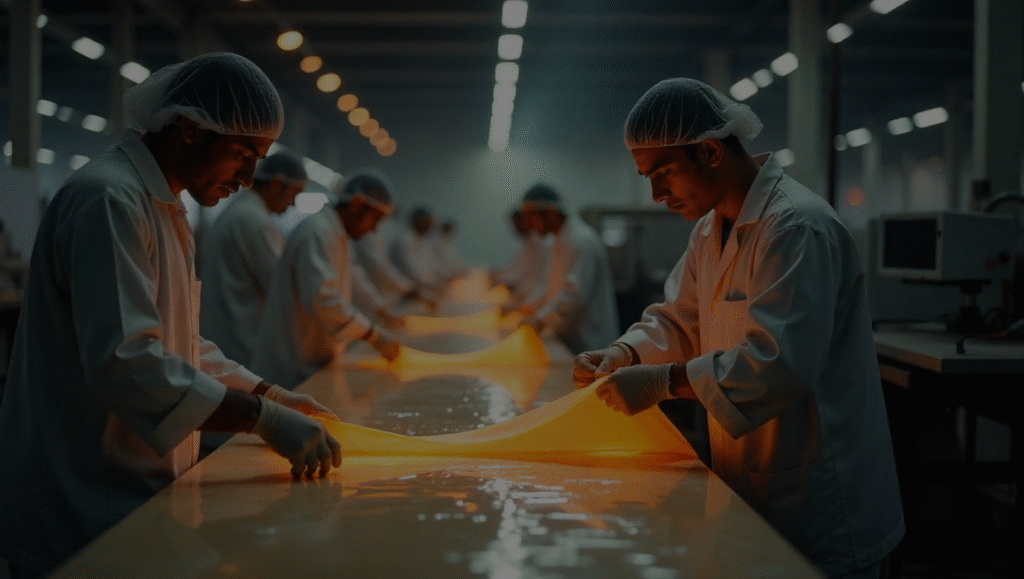
Mumbai, May 28, 2025 — India’s textile industry, worth USD 150 billion and expected to record a 10% CAGR until 2030, is embracing sustainability, and biodegradable coatings are transforming activewear and medical textiles.
Synthetic microplastic-free plant-based coatings provide durability, water resistance, and breathability while complying with worldwide environment goals.
Propelled by regulatory influence and customer preference for green products, these technologies aid India’s National Green Mission and the USD 1.8 billion activewear industry but are prevented from reaching a large scale by high expenses and scalability issues.
Synthetic coatings such as polyurethane (PU) and polyvinyl chloride (PVC) pervade conventional activewear and medical textiles, shedding microplastics that add to the 35% of oceanic microplastics derived from textiles, according to a 2024 UNEP report. As India produces 26 million tonnes of plastic waste each year, legislations such as the Plastic Waste Management Rules, 2016, and the EU’s REACH system are demanding microplastic-free solutions.
Consumer attitudes, with 70% of city dwellers opting for sustainable textiles according to a 2024 Nielsen survey, are increasing demand for biodegradable coatings in high-performing sectors.
Coatings based on plants, sourced from renewable origins such as starch, cellulose, and bio-based polyesters, provide a sustainable solution. In sportswear, where India’s market is expanding at 15% a year, starch-based coatings deliver water-repellency without microplastics, breaking down after 180 days under industrial composting, according to a 2023 IIT Bombay study.
Arvind Limited, among other companies, is using these coatings on yoga wear to deliver 20% improved breathability compared to PU, cutting carbon footprints by 25%. Cellulose coatings, with added nanocellulose, improve abrasion resistance by 30%, according to a 2024 CII report, and are thus best suited for running equipment.
Eco-activewear by Decathlon India, introduced in 2024, employs cellulose coatings, reducing production emissions by 15%.
Medical textiles, a USD 2 billion industry in India, require antimicrobial and fluid-resistance properties. Bio-based polyester coatings, sugarcane-based, provide fluid repellency at par with PVC, applied in surgical gowns by Vardhman Textiles.
These enzyme-developed coatings, which are biodegradable, decrease hospital waste by 20%, supporting the Swachh Bharat Mission.
Natural antimicrobial properties of chitosan, derived from crustacean shells, are taken up by startups such as GreenThread Solutions for wound dressings, delivering 99% bacterial reduction, according to a 2023 study.
These do not degrade into microplastics, unlike synthetic coatings, thus supporting India’s mission of cutting plastic waste by 70% by 2030.

Innovations are bridging performance gaps. Lignin-based paint, derived from India’s 20 million-ton pulp economy, enhances UV resistance by 25%, according to a 2024 IIT Delhi report, best for outdoor sportswear.
BASF recently exhibited hybrid coatings blending PLA and chitosan at an expo, with 90% biodegradation and durability equivalent to its synthetic equivalent. Nanotechnology in the form of graphene additives increases medical textile tear strength by 15%, best suited for applications with high stress. These developments meet BIS’s low-VOC regulations and REACH, which allows for exports, contributing to 20% of the Indian textile industry.
Government policies are driving up adoption. The Production-Linked Incentive (PLI) scheme, investing Rs. 50,000 crore in the National Research Foundation (NRF), encourages R&D for green textiles. The Raising and Accelerating MSME Performance (RAMP) scheme supports smaller companies, which make up 40% of the textiles, to adopt eco-friendly coatings. PM Gati Shakti enhances supply chain efficiency for bio-based raw materials.
2 million workers have been trained in advanced manufacturing since 2023 by the Skill India Digital Hub, although just 5% have skills in bio-coating applications, according to Nasscom.
There are still challenges. Biodegradable coatings are 20-30% more expensive than synthetic ones, capping MSME adoption at 10%, according to a 2024 SIDBI report. Performance constraints, such as reduced water resistance in wet conditions, need formulation adjustments. Infrastructure challenges, such as periodic power outages in Tier 2 towns, derail production, which costs SMEs Rs. 1-2 lakh every month, according to industry commentary. There is little awareness among smaller manufacturers, with cost being prioritized over sustainability, and regulatory lag in approving patents (4-6 years versus China’s 2) dampen innovation. ASEAN nation competition from abroad adds to the pressure.
Experts prescribe fixes. Subsidies under the Technology Upgradation Scheme can facilitate costs. Enlarging Skill India’s training in bio-based coatings can alleviate skill shortages.
Enhancing 5G connectivity and power dependability, as targeted under PM Gati Shakti, will facilitate production. Public-private collaborations with IITs can ramp up R&D. CII-initiated campaigns can enhance awareness amongst MSMEs and consumers, thus driving up demand.
Biodegradable coatings, in turn, are revolutionizing India’s medical and activewear textiles, providing plastic-free performance backed by sustainability as well as core.
With a USD 3 billion textile coating industry on the cards, by 2030, these technologies are central to meeting consumer and business regulatory expectations.
With cost, skill, and infrastructure hurdles overcome, Indian manufacturers can drive the world towards eco-friendly, green textiles, spinning a greener destiny for high-performance fabrics.
